How to Choose Keywords for SEO

Keywords are the backbone of a good SEO strategy.
If you wonder how to choose keywords for SEO, this step-by-step guide will set you up for a great start. We’ll cover all the details of keyword research—from identifying keywords to analyzing them and selecting the best ones for your business.
Before you dive in, create a free Semrush account to follow along and learn how to use keyword research tools to choose the right keywords for you.
Step #1: Find Relevant Keyword Ideas
Before choosing keywords you’ll target with your SEO strategy, you need to find keyword ideas first.
We’ll explore three basic methods:
- Finding your competitors’ keywords
- Finding keywords using a seed keyword
- Finding keywords you already rank for
Let’s dive in.
Finding Your Competitors’ Keywords
Getting inspiration from your competitors is probably the easiest way to find new keywords.
Just enter your domain and the domains of your competitors in Semrush’s Keyword Gap tool.

You probably know who your main competitors are. But once you enter your domain, the tool will suggest some domains to add to the comparison. You can pick from those, too.

Then, enter your target location and click the “Compare” button.

The tool will compare the keyword profiles of all the analyzed domains and provide an overview. As well as a comprehensive list of keyword opportunities.

Here, focus on the “Missing” and “Weak” tabs. These are keywords you don’t rank for at all (but your competitors do). Or keywords for which you rank at lower positions than your competitors.

If you have a new website and don’t rank for any keywords yet, you don’t need to enter your domain at all.
Instead, just enter five competitors and focus on the “Shared” tab.

This will list keywords all the analyzed domains rank for in the top 100 Google results.
Either way, the list will provide some relevant keyword ideas you can work with further. If all your competitors target those keywords, they’re probably relevant for you, too.
If you’re following along and found some interesting keyword ideas, you can jump to the next section, where we’ll discuss the key metrics to consider when choosing the right keywords for SEO.
Now, let’s take a look at the other two popular methods of finding relevant keywords.
Finding Keywords Using a Seed Keyword
A seed keyword is any keyword you enter into a keyword research tool to find other relevant keywords.
Let’s say you’re doing keyword research for a fitness blog.
Your seed keyword might be any broad keyword related to your niche, such as “fitness,” “workout,” or “strength training.”
Enter your seed keyword and your target location into Semrush’s Keyword Magic Tool.
Hit “Search.”

The tool will list keywords related to your seed keyword. Probably thousands of them.

But you don’t need to be overwhelmed. We’ll discuss how to narrow your list and choose the right keywords for you.
A good place to start is the left panel that lists “Keyword Groups” based on the most common words contained within the keyword phrases in the list.

In our example, we can see that popular keyword groups revolve around terms like “strength training program,” “strength training for weight loss,“ “strength training exercises,” or “strength training workout.”
You can also expand each of these groups and explore their subtopics.

You can repeat this process with various seed keywords. This will give you a great overview of your niche and the most important topics.
Finding Keywords You Already Rank for
Sometimes, you don’t need to look too far to find relevant keywords. All you need to do is take a look at keywords you already rank for.
You’ll probably find you don’t rank for many of them as highly as you would like—for example, you’re probably ranking for many keywords on the second page of Google results. This means you get minimal to no search traffic from them.
Once you find these keywords, you have two options:
- Better optimize your existing content for these keywords
- Create new content to target these keywords better
A great tool to identify keywords you already rank for in Google is Google Search Console (GSC).
Tip: If you’re not familiar with GSC, read our detailed guide to Google Search Console to learn more about this free Google tool.
Head to the “Search results” report under the “Performance” section in the left sidebar menu of GSC.

Here, you’ll see a graph with your results over time. And beneath that, under the “Queries” tab, a list of keywords you rank for.

Since we’ll want to work with the keywords further, the easiest way is to export the whole report. Just click the “Export” button in the top-right corner of the report.
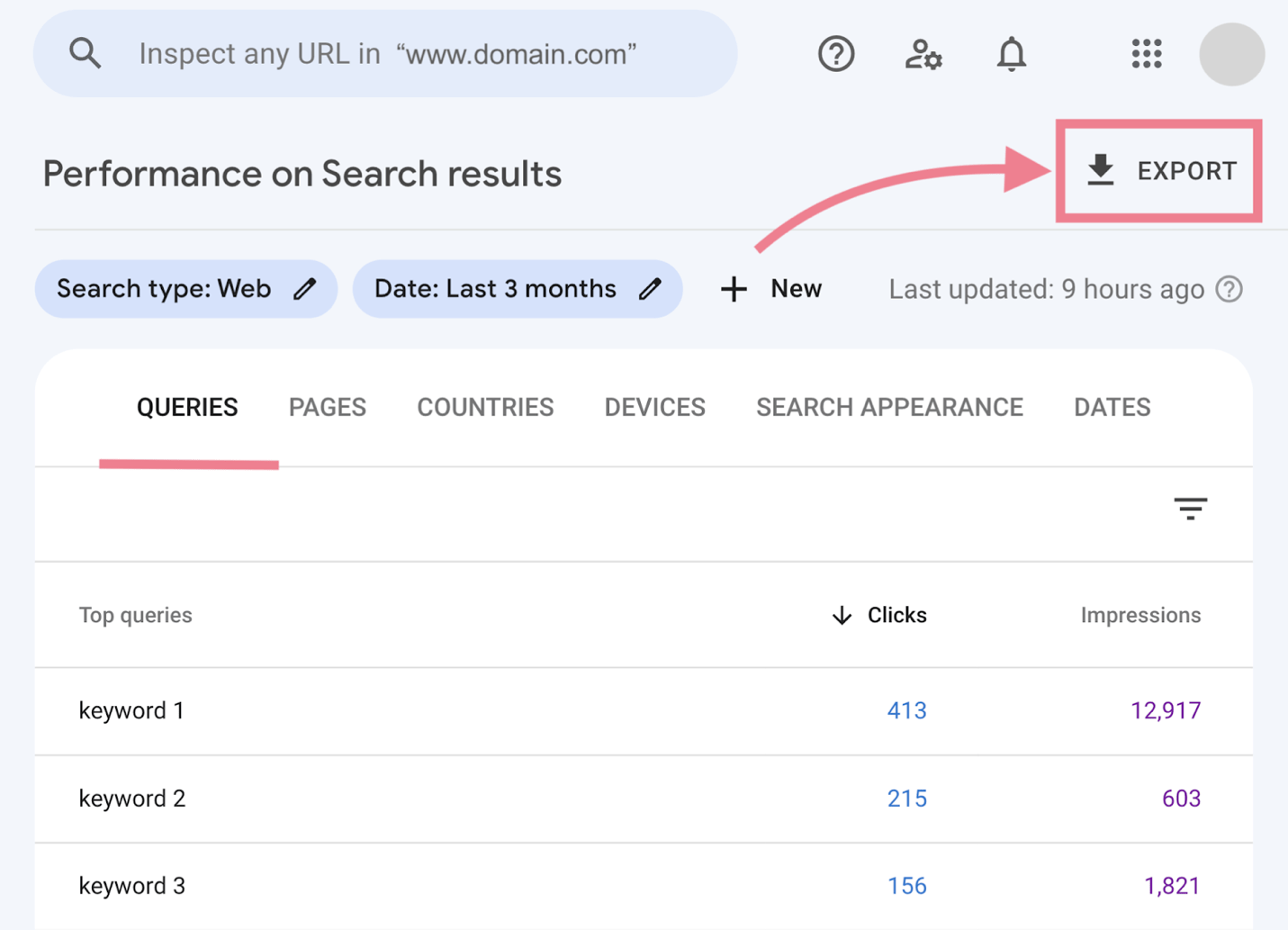
Pick your preferred format (e.g., Google Sheets). Open the document, and sort your keywords by “Position.” (The last column in the keyword list.)

Then, copy the keywords you rank for on the second search engine results page (SERP)—the ranking position will be between 11 and 20.
Open Keyword Manager and click the “+ Create list” button in the top-right corner.
Here, you’ll be asked to name your list. You can use “GSC positions 11-20” or something similar.
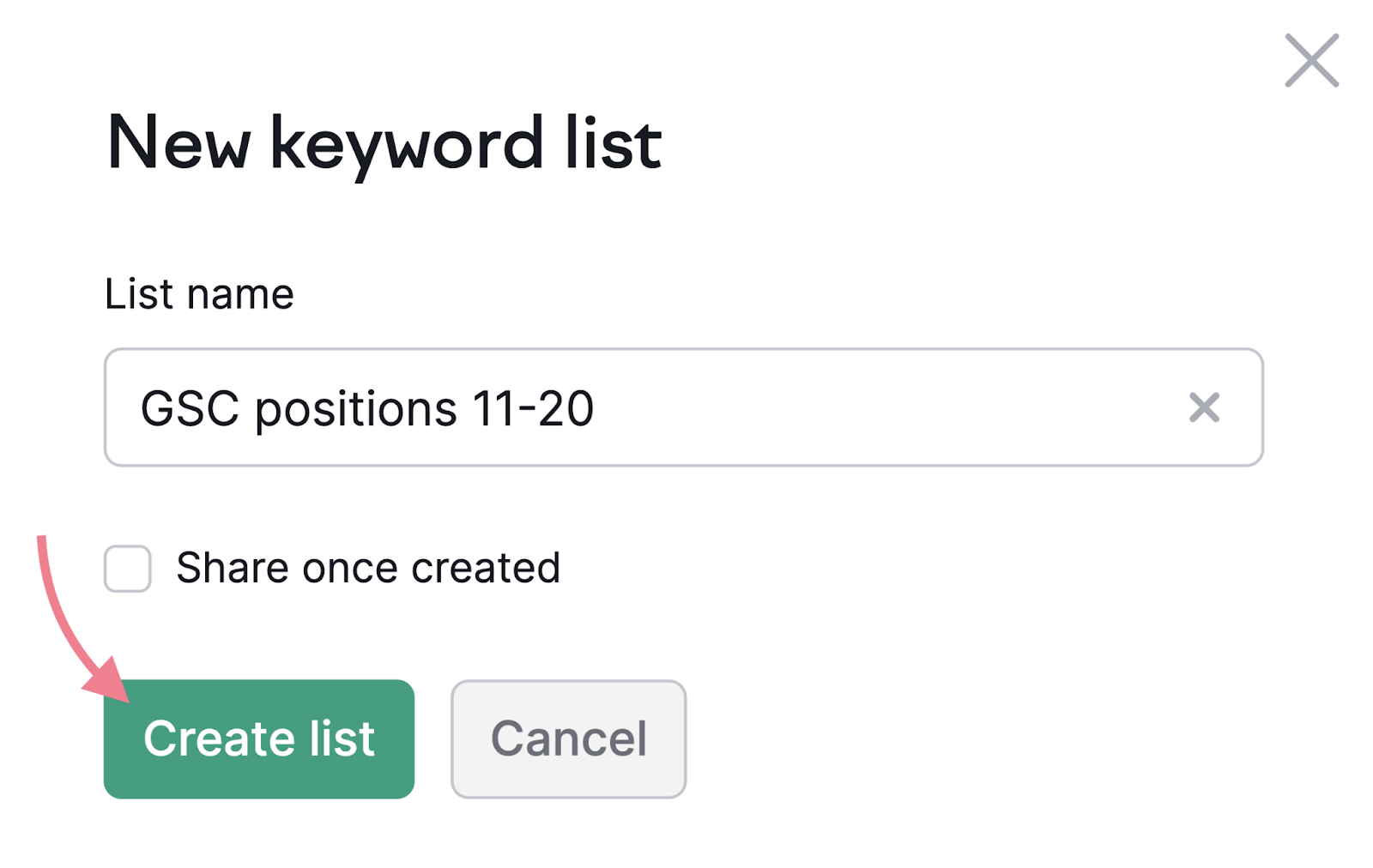
After creating the list, you can open it and click the “Import them manually” link.

Copy and paste the keywords from the sheet you exported from Google Search Console.
Now, you have imported into Semrush a list of keywords you rank for on the second SERP. So you can analyze them further.
This brings us to the next part of the keyword research process.
Step #2: Evaluate Keyword Metrics
The best keywords for SEO should strike the right balance between being popular on the one hand and easy to rank for on the other.
That’s why you always need to consider these two keyword metrics:
- Search volume: How many times a keyword is searched for
- Keyword difficulty: How hard it is to rank for the keyword
Let’s discuss each of them in detail.
Search Volume
Search volume tells us how many searches a keyword has on a monthly basis. The number is based on a 12-month average.
Here’s where you’ll find it in Keyword Magic Tool:

Search volume is an important metric to consider. If nobody searches for the keyword, you likely won’t get any search traffic even if you rank for it.
But it doesn’t mean you should only aim for keywords with thousands of searches.
The so-called long-tail keywords—very specific search queries that consist of multiple words—usually have lower search volume. However, there are so many of them that it would be unwise to ignore them in your content strategy.
Added together, long-tail keywords make up a significant number of searches. And because they are more specific, they tend to convert better.
For example, a user who searches for “men’s brown wool half coat” is probably more likely to make a purchase than someone who searches for a general term like “coat.”

So, let’s say you only want to see keywords with at least 100 monthly searches.
In the Keyword Magic Tool, click the “Volume” filter.

Then, enter “100” as the “From” value under the “Custom range” and hit “Apply.”

Now, you’ll only see keywords that have at least 100 average monthly searches.
You can experiment with this number based on the size of your niche and the specificity of your topic.
Keyword Difficulty
Keyword difficulty is a metric that estimates how hard it is to rank in the top 10 organic Google search results for the keyword on a scale from 0 to 100.
In the Keyword Magic Tool, you’ll find it under the “KD %” column.

KD % is a great metric to help you find keyword opportunities with relatively low competition.
After all, if the keyword you found is too difficult to rank for due to very high competition, it is probably not worth your effort. Simply because you won’t be able to rank for it unless you have a very authoritative website.
There’s usually an indirect correlation between keyword difficulty and search volume.
For example, the keyword “wireless mouse” has 33,100 searches per month. But it also has a KD % of 80, which means it is almost impossible to rank for unless you’re a very authoritative website.

Now, let’s click the “KD %” filter and set the difficulty level to a lower level—let’s say between 0 and 30.

The search volumes of the keywords are much lower now. But you’re much more likely to rank for them.
Remember that, at any time during your keyword research process, you can save the keywords into a keyword list.
In Semrush, you can do so by simply selecting the check box next to the keywords you want to save. Then, hit the “+ Add to list” button in the top-right corner of the keyword table.

You can then create a new list by clicking the “Create new empty list” link at the bottom of the pop-up window.
All your lists will be saved in the Keyword Manager tool, where you can keep and manage all your keywords.
After adding a keyword to a list, a green check mark symbol will appear next to it in the keyword table.


Step #3: Identify Search Intent
Search intent refers to the underlying goal behind a user’s search query. It’s the reason why someone is searching for a particular term and what they hope to achieve from their search results.
It will help you understand the keyword better and:
- Shape your content strategy more precisely
- Eliminate keywords that are irrelevant to your current needs
- Choose the type of content you’ll need to rank for the keyword
- Satisfy users’ needs better
- Evaluate the business value of the keyword
We differentiate between four main search intent types:
- Navigational intent: A user wants to find a specific page (e.g., “amazon kindle login”)
- Informational intent: A user wants to find specific information about something (e.g., “what is amazon kindle”)
- Commercial intent: A user wants to do research before making a conversion (e.g., “amazon kindle paperwhite review”)
- Transactional intent: A user wants to complete a conversion, usually to purchase something (e.g., “amazon kindle paperwhite cover”)


The best way to identify the search intent behind a keyword is to take a look at the SERPs.
Based on the types of pages that rank for the keyword (and the SERP features that appear), we can know which search intent Google attributes to the keyword.
For example, Google knows users searching for “what is the best kindle” are not ready to convert. They’re not interested in product pages. The search intent is commercial, not transactional.
Indeed, the top search results only contain reviews:


If you’re doing keyword research for your product page featuring the most popular Kindle models, “what is the best kindle” is not the right target keyword for you.
So, knowing the search intent of a keyword can help you choose the right keywords. And filter out those that are irrelevant to your current needs.
Identifying the search intent can also help you estimate the business value of a keyword.
A user goes through various stages of the buyer’s journey. And they use different types of keywords for each of the stages.


Knowing the search intent of keywords can help you prioritize keywords that are more likely to result in a desired action—whether it is a purchase, subscription, lead generation, or something else.
Side note: This doesn’t mean you should only focus on keywords with commercial and transactional intents. For example, having a blog that focuses on informational queries can be a great way to get backlinks, increase brand awareness, and target users in the awareness stage of the buyer’s journey.
However, it may be difficult to check the SERP results for every single keyword you find.
That’s why all the Semrush keyword research tools provide useful “Intent” info that helps you identify the search intent category quickly and effectively.
In the Keyword Magic Tool, it looks like this:


You can also use filters to only show the search intent types you want.
For example, if you’re doing keyword research for a blog, you’ll want to focus on keywords with informational and commercial intent.
Just click the “Intent” selector at the top of the keyword list and check the desired intent types. Hit “Apply.”


Now, the list only contains keywords that fall into these two intent categories.
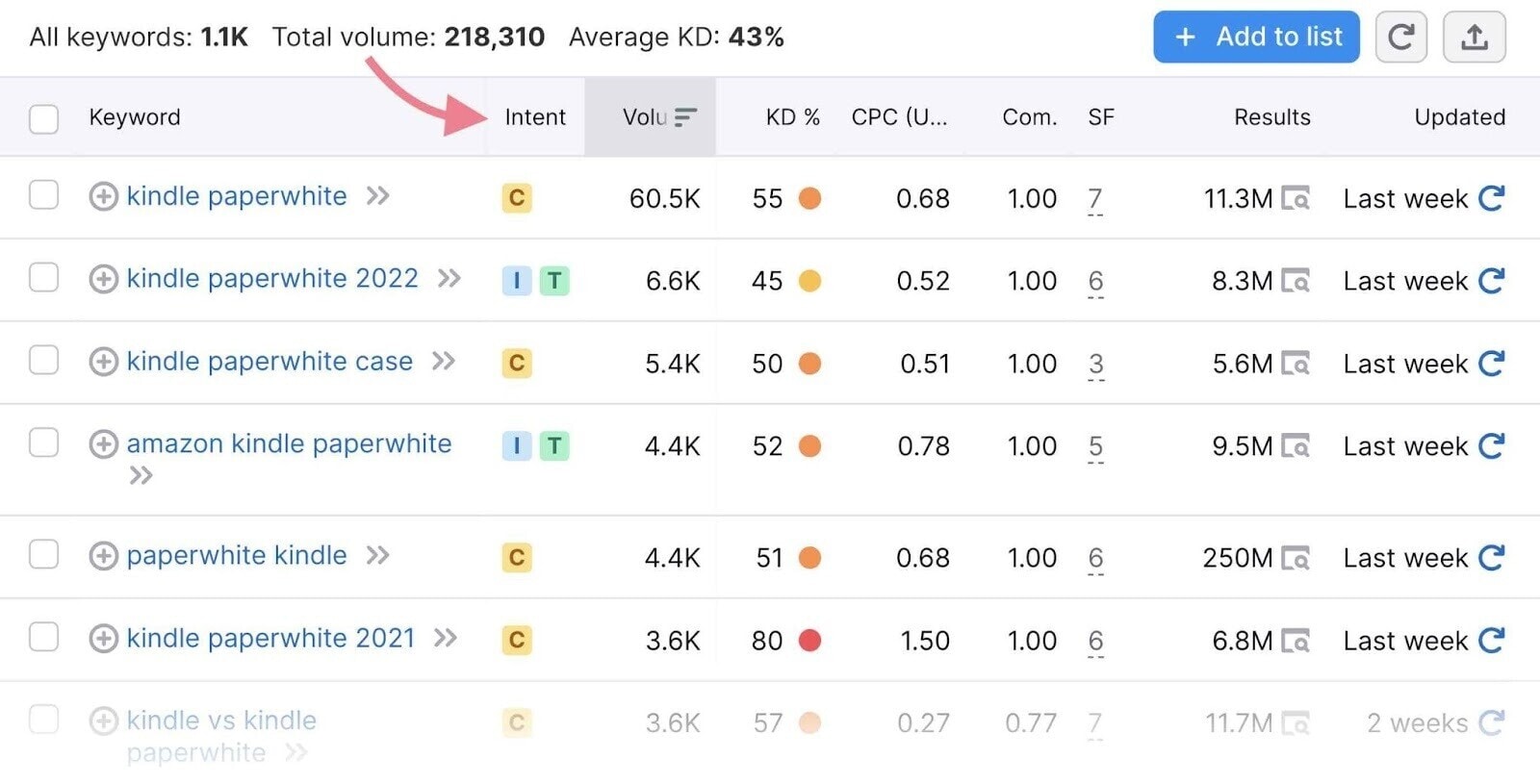

As you can see, the “Intent” metric in Semrush can help you analyze the search intent behind the keyword without looking at the actual search results for every single keyword.
But you still should look at the SERPs for your target keywords.
In fact, SERP analysis is an important and natural next step in better understanding the search intent. Let’s take a look at what it involves.
Step #4: Analyze the SERP
SERP analysis is the process of examining the SERPs for a particular keyword.
It involves analyzing the specific elements of the SERP (like featured snippets or People Also Ask (PAA) questions). As well as its top-performing pages (and their title tags, headings, subheadings, content angles, and comprehensiveness).
Conducting SERP analysis is not difficult. Just take a look at the search results and go through the top-ranking pages, one by one.
You can either type your target keyword in Google manually or use the Keyword Overview tool.
First, enter your keyword and the target location. Then hit “Search.”


Below, in the “SERP Analysis” section, you’ll see the list of search results for the analyzed keyword:


The advantage of this method is that you’ll also see other useful metrics, such as:
- Page AS: The Authority Score of the page, on a scale from 0 to 100
- Domains: The number of domains linking to the page
These can help you get a better idea of what it takes to rank for the keyword.
You can analyze each URL by clicking the blue link. (This will open the URL in the Organic Research tool.) Or the icon next to it. (This will open the URL in a new window.)
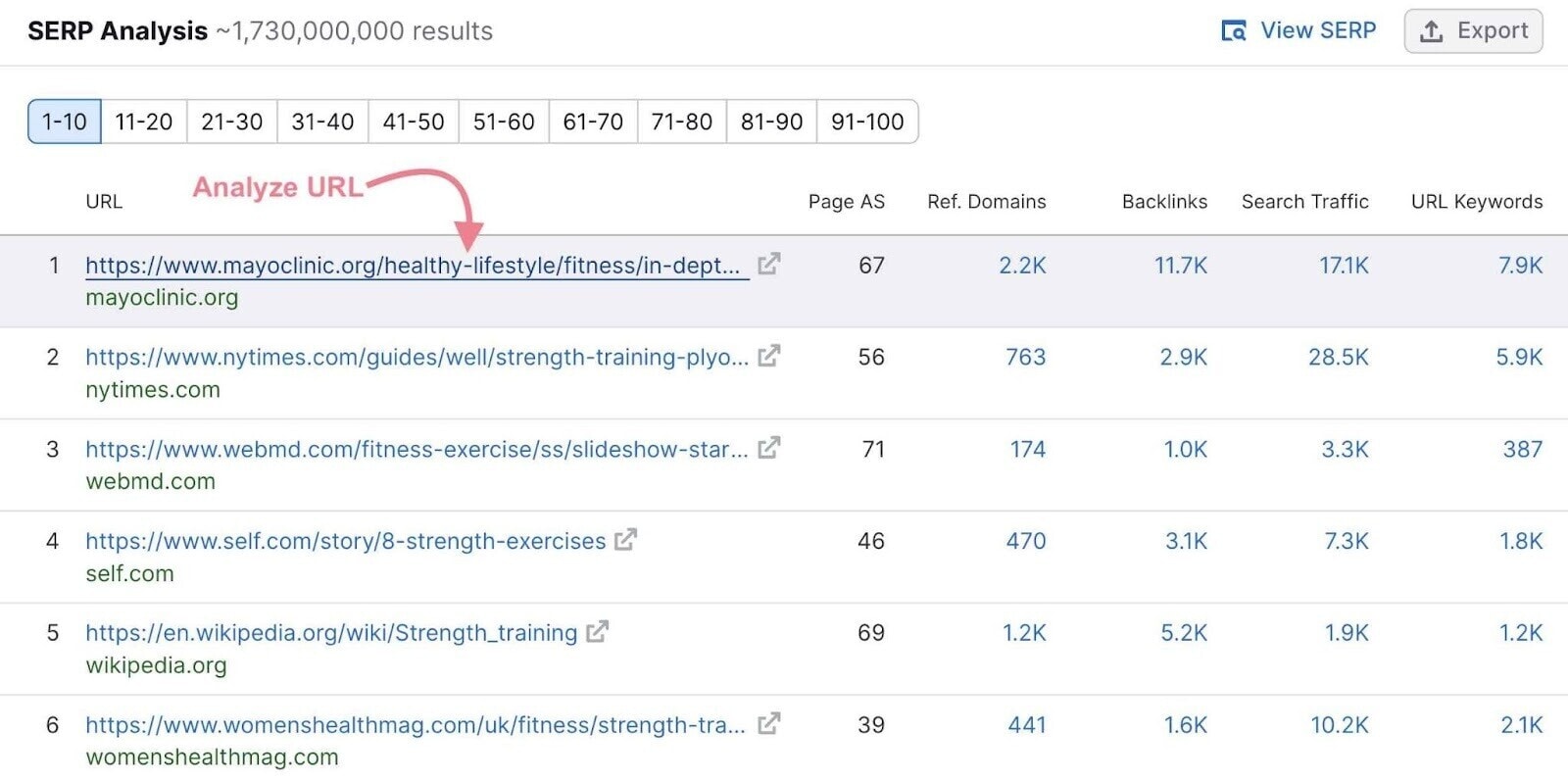

Finally, you can click the “View SERP” button in the top-right corner and see the snapshot of the actual search results page in Google.
All of this can help you understand the search intent even better.
Namely, because it helps you identify the following:
- What type of content users expect to see:For example, if all the search results are listicle blog posts, it will likely be best to target that keyword with a listicle
- Related topics and questions:See what other things users are searching for (e.g., through the PAA section)
- Gaps in the content that’s currently ranking:This gives you an opportunity to create something unique and valuable
Last but not least, SERP analysis can help you estimate the potential organic click-through rate (CTR).
Click-through rate is a metric that tells you what percentage of users who search for a keyword in Google will click on the search result.
The higher the page ranks on the SERP, the higher the CTR.
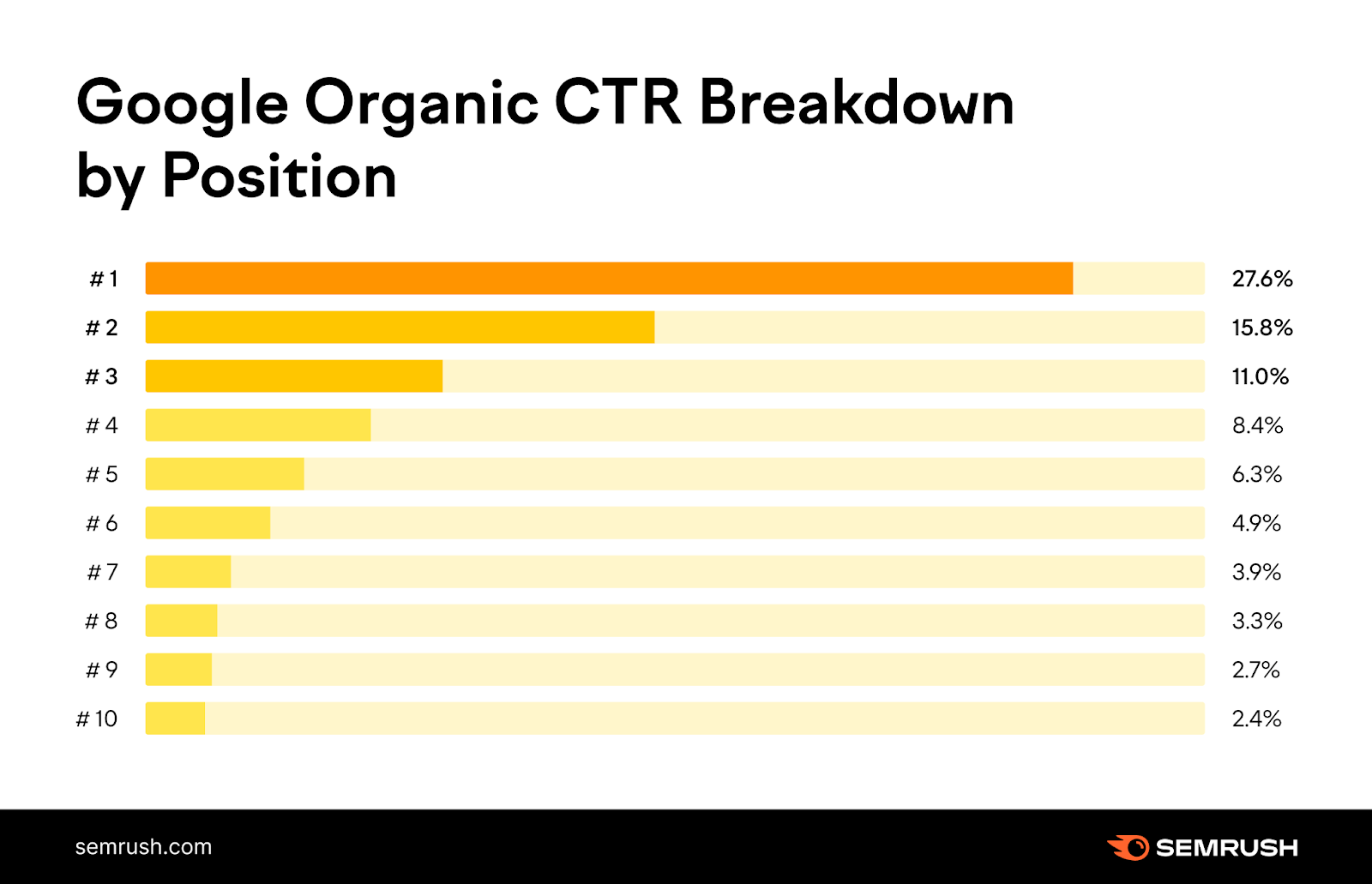

However, other factors can also influence CTR.
One of the most significant factors is the presence of various SERP features. Such as ads, featured snippets, PAA questions, etc.
Various features have a different impact on CTR. But usually, the more SERP features appear on the SERP, the lower the CTR of the organic results.
Also, with the rise of Google’s Knowledge Graph, there has been a significant increase in search results that answer the user’s question directly in the SERP. As a result, users do not click through to any of the ranking pages. These are called zero-click searches.
According to Semrush’s Zero-Clicks Study, about a quarter of all searches end up with no click.


You need to consider all of this when choosing keywords for your SEO strategy.
It may be difficult to estimate the impact of various SERP features on CTR. However, a handy metric called “Click Potential” in Semrush’s Keyword Manager tool can help.
Click Potential is a percentage that estimates the probability of getting traffic to your page if it ranks in the top spots for the keyword.


A number closer to 100% means SERP features do not heavily impact the organic CTR. Lower percentages mean your CTR will be lower even if you rank No. 1 for the keyword.
So, if you haven’t done so yet, now is a good time to save your keywords to a keyword list in Keyword Manager.
Just select the keyword and click the blue “+ Add to list” button at the top of the keyword table.



Once you have your keywords in the keyword list, you can analyze them further, organize them by adding tags, and prioritize them by various factors.
Step #5: Select Primary Keywords
A primary keyword (also called a “target keyword”) is a keyword that is the best representation of a certain topic. It is also often the most searched keyword within that topic. We use the primary keyword to optimize the page. By placing it in elements such as:
- Title tag
- Main heading
- First paragraph
- URL of the page
Here’s the rule of thumb:
Each page on your site should have a primary keyword. This way, you’ll avoid keyword cannibalization and make sure both users and search engines know immediately what your content is primarily about.
In other words, the primary keyword helps you focus your optimization efforts for each page on one specific keyword that represents the topic the page is about. (That’s why it is often called a “focus keyword,” too.)
Here’s how to identify your primary keyword for a topic:
Let’s say you found the keyword “long head tricep workout” for your fitness blog.


It has a solid search volume and isn’t that hard to rank for. The search intent is commercial. And a closer look at the search results shows that the SERP contains blog posts about how to exercise the long head of the triceps muscle. Looks like you found a great keyword you can target by writing a blog post.
The only problem is that this keyword is not the best representation of this topic.
Let’s take a look at the top-ranking page—a post by Kustom Kit Gym Equipment—and enter its URL into Semrush’s Organic Research.
A quick look at the “Top Organic Keywords” section will tell you that your keyword is not the highest-volume keyword the page ranks for. Not even close.


In fact, the page ranks No. 1 for five other keywords with equal or higher search volume—with the keyword “long head tricep exercises” being the most popular.


Although the “long head tricep workout” keyword has solid metrics, it would be wiser for us to primarily target the keyword “long head tricep exercises”—it has a higher search volume and covers the same topic and intent.
Most importantly, Google obviously sees the two keywords as the same, as it ranks the same pages for both of them.
You can also confirm this by using the SEO Content Template.
Enter both keywords into the tool and hit “Create content template.”


If you look at the top-ranking pages for both of them, you’ll notice that the results are basically the same.
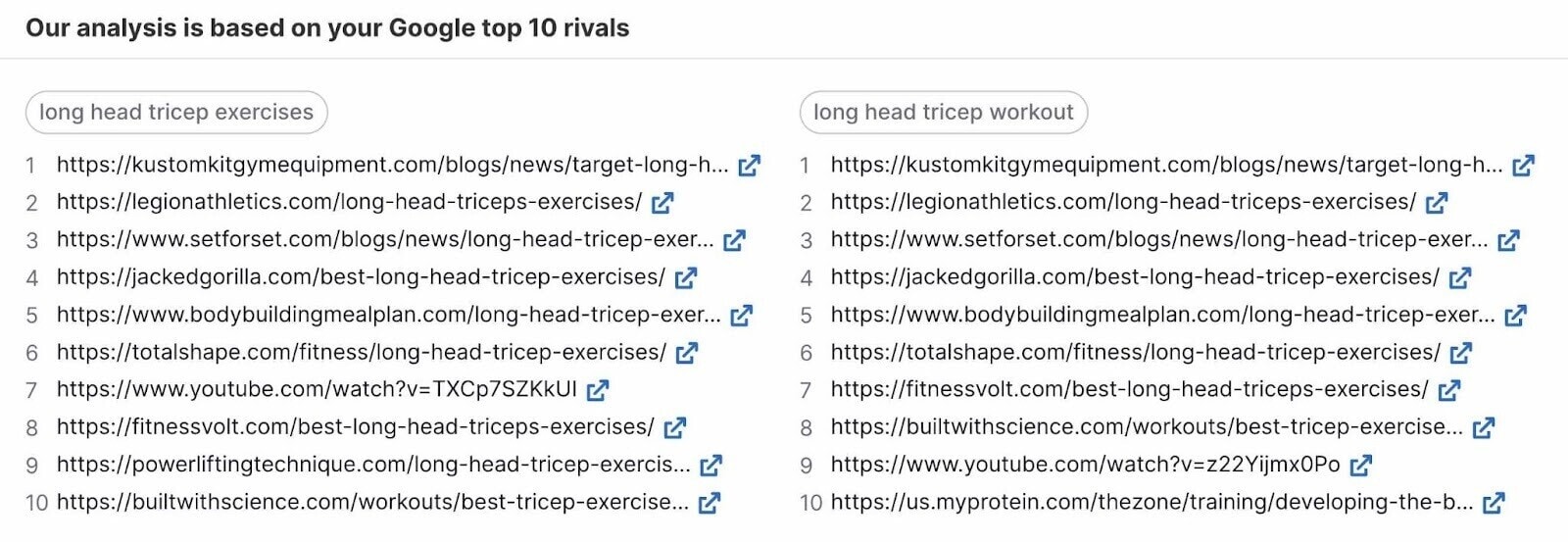

This is nothing unusual. If you rank for any bigger keyword, you’ll also rank for many other keywords. Google is smart enough to understand what keywords have the same intent and serve the same (or similar) results.
As you can see, the article by Kustom Kit Gym Equipment ranks for 549 keywords.


Of course, it doesn’t use all of them in the text.
In fact, the page doesn’t even contain the original keyword—“long head tricep workout.” (Neither in the text, nor in the source code.) But it ranks No. 1 for it.


This doesn’t mean you can’t or shouldn’t also use other relevant keywords with lower search volume.
These, however, would be secondary keywords. Meaning you can use them throughout the text as synonyms to avoid repetition, but they’re not your primary target.
You shouldn’t try to use every single keyword you find at all costs.
Once you identify your primary keyword, optimize your page around it. You can pick a handful of other secondary keywords—especially those with significant search volumes—and use them in the text, too.
That’s it.
Don’t force it. Don’t over-optimize your content at the expense of readability. Do not stuff your keywords. (Google might detect it and penalize you.)
Next Steps
Choosing the right keywords for SEO is crucial for ranking higher and driving search traffic to your website. However, maybe it’s time to simply learn by doing and start your own keyword research journey.
Happy researching!
Source: Semrush